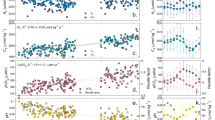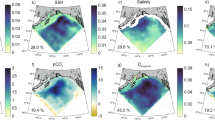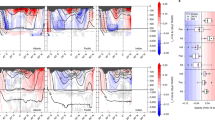Abstract
Since the beginning of the Industrial Revolution humans have released ∼500 billion metric tons of carbon to the atmosphere through fossil-fuel burning, cement production and land-use changes1,2. About 30% has been taken up by the oceans3. The oceanic uptake of carbon dioxide leads to changes in marine carbonate chemistry resulting in a decrease of seawater pH and carbonate ion concentration, commonly referred to as ocean acidification. Ocean acidification is considered a major threat to calcifying organisms4,5,6. Detecting its magnitude and impacts on regional scales requires accurate knowledge of the level of natural variability of surface ocean carbonate ion concentrations on seasonal to annual timescales and beyond. Ocean observations are severely limited with respect to providing reliable estimates of the signal-to-noise ratio of human-induced trends in carbonate chemistry against natural factors. Using three Earth system models we show that the current anthropogenic trend in ocean acidification already exceeds the level of natural variability by up to 30 times on regional scales. Furthermore, it is demonstrated that the current rates of ocean acidification at monitoring sites in the Atlantic and Pacific oceans exceed those experienced during the last glacial termination by two orders of magnitude.
This is a preview of subscription content, access via your institution
Access options
Subscribe to this journal
Receive 12 print issues and online access
$209.00 per year
only $17.42 per issue
Buy this article
- Purchase on Springer Link
- Instant access to full article PDF
Prices may be subject to local taxes which are calculated during checkout
 .
.
 trend.
trend.
 trends in the context of the Last Glacial Termination.
trends in the context of the Last Glacial Termination.
Similar content being viewed by others
References
Houghton, R. Revised estimates of the annual net flux of carbon to the atmosphere from changes in land use and land management 1850–2000. Tellus B 55, 378390 (2003).
Boden, T., Marland, G. & Andres, R. Global, Regional, and National Fossil-Fuel CO 2 Emissions Tech. Rep. http://dx.doi.org/10.3334/CDIAC/00001V2010 (Carbon Dioxide Information Analysis Center, Oak Ridge National Laboratory, US Department of Energy, 2010).
Canadell, J. et al. Contributions to accelerating atmospheric CO2 growth from economic activity, carbon intensity, and efficiency of natural sinks. Proc. Natl Acad. Sci. USA 104, 18866–18870 (2007).
Raven, J. et al. Ocean Acidification Due to Increasing Atmospheric Carbon Dioxide 60, Tech. Rep. (The Royal Society, 2005).
Kleypas, J. A. et al. Impacts of Ocean Acidification on Coral Reefs and Other Marine Calcifiers: A Guide for Future Research. Tech. Rep. (NSF, NOAA, and the US Geological Survey, 2006).
National Research Council Report Ocean Acidification: A National Strategy to Meet the Challenges of a Changing Ocean 152 (National Academy of Science, 2010).
Riebesell, U. et al. Reduced calcification of marine plankton in response to increased atmospheric CO2 . Nature 407, 364–367 (2000).
Langdon, C. & Atkinson, M. J. Effect of elevated pCO2 on photosynthesis and calcification of corals and interactions with seasonal change in temperature/irradiance and nutrient enrichment. J. Geophys. Res. 110, C09S07 (2005).
Jungclaus, J. H. et al. Climate and carbon-cycle variability over the last millennium. Clim. Past 6, 723–737 (2010).
Cooley, S. R., Lucey, N., Kite-Powell, H. & Doney, S. C. Nutrition and income from molluscs today imply vulnerability to ocean acidification tomorrow. Fish Fish.http://dx.doi.org/10.1111/j.1467-2979.2011.00424.x (2011).
Manzello, D. P. Coral growth with thermal stress and ocean acidification: lessons from the eastern tropical Pacific. Coral Reefs 29, 749–758 (2010).
McNeil, B. & Matear, R. Southern Ocean acidification: A tipping point at 450-ppm atmospheric CO2 . Proc. Natl Acad. Sci. USA 105, 18860–18864 (2008).
Feely, R. A., Sabine, C., Hernandez-Ayon, J. M., Ianson, D. & Hales, B. Evidence for upwelling of corrosive acidified water onto the continental shelf. Science 320, 1490–1492 (2008).
Moy, A. D., Howard, W. R., Bray, S. G. & Trull, T. W. Reduced calcification in modern Southern Ocean planktonic foraminifera. Nature Geosci. 2, 276–280 (2009).
Yamamoto-Kawai, M., McLaughlin, F. A., Carmack, E. C., Nishino, S. & Shimada, K. Aragonite undersaturation in the Arctic Ocean: Effects of ocean acidification and sea ice melt. Science 326, 1098–1100 (2009).
Ilyina, T. et al. Early detection of ocean acidification effects on marine calcification. Glob. Biogeochem. Cycles 23, GB1008 (2009).
Atzesu-Scott, K. et al. Calcium carbonate saturation states in the waters of the Canadian Arctic Archipelago and the Labrador Sea. J. Geophys. Res. 115, C11021 (2010).
Beaufort, L. et al. Sensitivity of coccolithophores to carbonate chemistry and ocean acidification. Nature 476, 80–83 (2011).
Byrne, R. H., Mecking, S., Feely, R. A. & Liu, X. Direct observations of basin-wide acidification of the North Pacific Ocean. Geophys. Res. Lett. 37, L02601 (2010).
Gledhill, D. K., Wanninkhof, R., Millero, F. J. & Eakin, M. Ocean acidification of the Greater Caribbean Region 1996–2006. J. Geophys. Res. 113, C10031 (2008).
Lüthi, D. et al. High-resolution carbon dioxide concentration record 650,000–800,000 years before present. Nature 453, 379–382 (2008).
Dore, J. E., Lukas, R., Sadler, D. W., Church, M. J. & Karl, D. M. Physical and biogeochemical modulation of ocean acidification in the central North Pacific. Proc. Natl Acad. Sci. USA 106, 12235–12240 (2009).
Bates, N. R. Interannual variability of the oceanic CO2 sink in the subtropical gyre of the North Atlantic Ocean over the last two decades. J. Geophys. Res. 112, C09013 (2007).
Santana-Casiano, J. M., González-Dávila, M., Rueda, M.-J., Llinás, O. & González-Dávila, E. F. The interannual variability of oceanic CO2 parameters in the northeast Atlantic subtropical gyre at the ESTOC site. Glob. Biogeochem. Cycles 21, GB1015 (2007).
Hoegh-Guldberg, O. Coral bleaching, Climate Change and the future of the worlds coral reefs. Rev. Mar. Freshwat. Res. 50, 839–866 (1999).
Doney, S. C. The growing human footprint on coastal and open-ocean biogeochemistry. Science 328, 1512–1516 (2010).
Fabricius, K. et al. Losers and winners in coral reefs acclimatized to elevated carbon dioxide concentrations. Nature Clim. Change 1, 165–169 (2011).
McLeod, E. et al. Warming seas in the coral triangle: Coral reef vulnerability and management implications. Coast. Manag. 38, 518–539 (2010).
Acknowledgements
This study was funded by The Nature Conservancy (www.nature.org) and National Science Foundation (NSF) grant #0902133. AT is supported by the Japan Agency for Marine-Earth Science and Technology (JAMSTEC) through its sponsorship of the International Pacific Research Center and NSF grant #0902551. We thank S. Lorenz for conducting the MPI-ESM experiments. This is International Pacific Research Center contribution number 829.
Author information
Authors and Affiliations
Contributions
The paper was written by T.F. and A.T. Data analysis and interpretation were carried out by T.F., A.T., M.H., D.K.G., N.R.B., M.J.C., J.E.D., M.G-D., J.M.S-C., T.I., J.H.J., M.O.C., E.M. and A.M. Observational data were provided by N.R.B., M.J.C., J.E.D., M.G-D. and J.M.S-C. Data for the Caribbean region were calculated by D.K.G. Last Glacial Maximum modelling data were provided by T.F., M.O.C., A.A-O. and A.M.
Corresponding authors
Ethics declarations
Competing interests
The authors declare no competing financial interests.
Supplementary information
Rights and permissions
About this article
Cite this article
Friedrich, T., Timmermann, A., Abe-Ouchi, A. et al. Detecting regional anthropogenic trends in ocean acidification against natural variability. Nature Clim Change 2, 167–171 (2012). https://doi.org/10.1038/nclimate1372
Received:
Accepted:
Published:
Issue Date:
DOI: https://doi.org/10.1038/nclimate1372
This article is cited by
-
Multi-temporal variability forecast of particulate organic carbon in the Indonesian seas
Environmental Monitoring and Assessment (2023)
-
Episodic sandstone-type uranium mineralization in Asia during the Late Mesozoic-Cenozoic
Science China Earth Sciences (2023)
-
Regional sensitivity patterns of Arctic Ocean acidification revealed with machine learning
Communications Earth & Environment (2022)
-
Sulfur bacteria promote dissolution of authigenic carbonates at marine methane seeps
The ISME Journal (2021)
-
Influence of Acidification and Warming of Seawater on Biofouling by Bacteria Grown over API 5L Steel
Indian Journal of Microbiology (2021)



